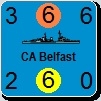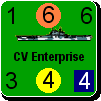AllenK
Posts: 7259
Joined: 2/17/2014
From: England
Status: offline

|
quote:
ORIGINAL: composer99
Thanks for going into detail. It's always nice to see players go into that kind of depth.
(For what it's worth, I think the US should have gone for the Japanese CVs and let the invaders go through. Midway's not so crucial that it can't be bypassed.)
A very good point and alternative view of what the USN should have struck first. Looking through the various AAR's and other threads, I'm pretty sure there would be adherents to each of the options.
Looking at it economically, an Amph (3+4 BP) and the Inf (3 BP), making a 10 BP loss is greater than a CV (2+2 BP), Air (1 BP) and pilot (2 BP), making 7 BP. Hm.... looking at it that way, what on earth were the IJN doing even mounting the Op? Ah yes, they were the bait to draw out the USN. It nearly worked. The IJN still did significant damage despite a lot of die rolls going in favour of the Americans, starting with their CV bomber cleared through in the first round of air combat.
Out of interest, I'll play out an alternative version where the USN sinks an IJN CV (as first strike it would have been a 4 pointer) instead of the Amph. In round 2 the results would have been the same against the IJN but probably reduced against the USN due the weakened IJN air. It would have ended up with the USN facing 4 CV's to either 1 or 2. If it was 4 to 1, they would have bugged out, leaving the invasion to continue.
What if it was 4 to 2? Both sides decide to duke it out for another round of combat. First the search rolls. The USN roll 2, spotting the IJN and the IJN roll 6 (I have a pair of D10). With the USN in the 1 box and the IJN in the 3 box, the result is 3 surprise points to the Allies (I think). The USN spends 2 points increasing it's air to air value by 1. Not being able to remember exactly the aircraft involved but, as they are relatively even, this would probably put the Allies either 0 or +1. Round 1, the allies roll a 7 (either a DA or an AA). If the US were choosing a bomber would be aborted. The IJN would abort the front fighter. We'll park this for now. IJN roll a 5 (DX) and the US destroy their front and only fighter. Remaining IJN bombers are cleared through. Second round, the USN are now around -2. US roll a DA and IJN abort a fighter, IJN roll a 7 and aborts the US bomber.
This leaves either 1 or 2 IJN bombers to attack the US fleet. AA factors would have been around the 14-16 mark. Against 1 bomber lowest 2 of 5 (9, 2, 3, 6, 5). For 5 points total, the bomber is shot down. If 2 got through, highest 1 of 2 (4, 2) reduces the bombs by 4 giving something like 2 points to attack. The result something like a D or possibly a D and A. The IJN try the D on a CV and, true to form, roll a 10 aborting the CV. The A is immaterial.
Either way, the US is down to one functional CV and aborts the area. In the resulting invasion, the Japanese Inf (an 8 factor unit) plus gunfire support give +16 and the roll of 10 sees Midway fall to the Japanese. The Japanese rebase Subs and long-range NAV's/FTR's to the island and set about trying to put Pearl out of supply. Do the US stay and fight out a supply battle with the Japanese (they will be challenged keeping Midway topped up) or relocate their Pacific base and if so, where? Pago Pago, Brisbane, Rabaul? They are all a long way from the States and they haven't yet managed to get Rabaul in supply? Or do they retire to San Diego? Ah, what might have been ...
< Message edited by AllenK -- 9/22/2014 3:19:48 PM >
|
 Printable Version
Printable Version












 New Messages
New Messages No New Messages
No New Messages Hot Topic w/ New Messages
Hot Topic w/ New Messages Hot Topic w/o New Messages
Hot Topic w/o New Messages Locked w/ New Messages
Locked w/ New Messages Locked w/o New Messages
Locked w/o New Messages Post New Thread
Post New Thread